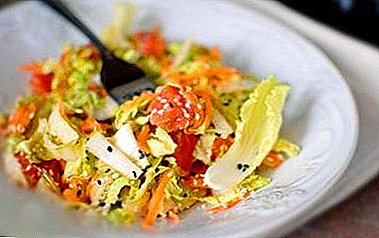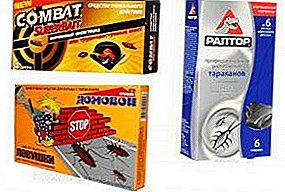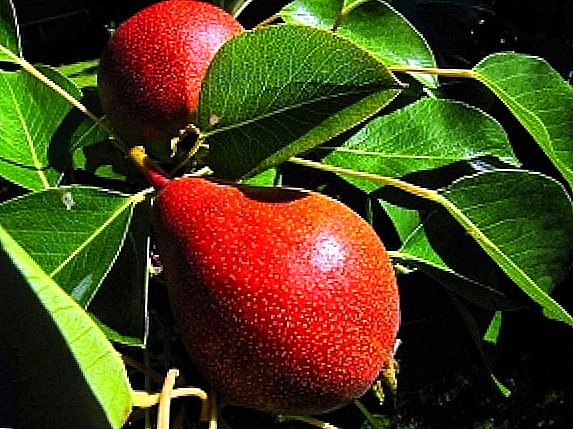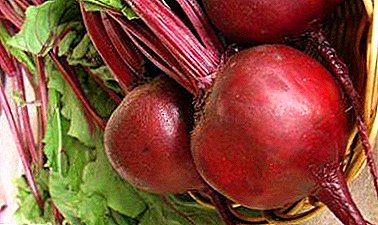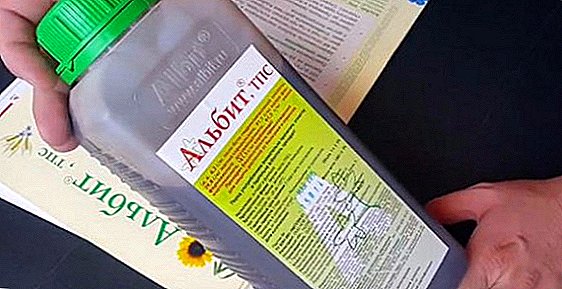 Among the existing indoor plants to meet a representative of the Japanese archipelago is not so simple. Bright, but at the same time, such a distant species diversity of the vegetation of the island state could not conquer the domestic gardener and achieve popularity. However, there are exceptions. One of these is the representative of the Araliev family - Fatsia. In this article we will look at what this plant actually is, find out what the flower of the fatsia is, and how to care for this species correctly.
Among the existing indoor plants to meet a representative of the Japanese archipelago is not so simple. Bright, but at the same time, such a distant species diversity of the vegetation of the island state could not conquer the domestic gardener and achieve popularity. However, there are exceptions. One of these is the representative of the Araliev family - Fatsia. In this article we will look at what this plant actually is, find out what the flower of the fatsia is, and how to care for this species correctly.
Botanical description
Fatsia belongs to the typical dicotyledonous species that are included in the family Araliaceae (Aralia). The Japanese islands are traditionally considered to be the natural habitat of representatives, as well as Taiwan and a few areas of South Korea. Fatsia owes its name to Fatsi Island, whose name means “eight” in translation, which vividly reflects the division of the leaf blade of the species into 8 blades.
Did you know? Fatsia - it is a close relative of a medicinal herb such as ginseng.

The division into cotyledons at the embryo is clear: the cotyledons are strictly opposite each other. This species is a representative of woody plants, which in nature can reach a height of about 4 meters. However, this is not happening at home, since the Fatsia room does not exceed 1.5 meters in height.
In this case, the lamina in diameter does not reach more than 40 cm, and the leaves themselves are arranged on the trunk in alternate or spiral sequence and have a bright green tint. The leaves have a pointed shape closer to the top and are divided, on average, into 8 lobes, 5-10 cm wide each.
Learn about the intricacies of caring for other indoor plants: pahira, cicasso, peo, calceolaria, golden whiskers, pelargonium, stocks, coffee tree, cattleya, araucaria, lantana, nepenthes, zhiryankoy, mandarin, left, violet, primula.
Fatsia is covered with flowers in November. During this period, the trunk is overgrown with small and rather unremarkable flowers, the color of which varies from creamy white to yellow-green, and the diameter is on average about 3 cm. The bud of the plant is egg-shaped and is divided into 5 petals.
Flowers are collected in an umbrella inflorescence. After flowering, in most cases, a fruit about 5 mm in size appears on the fatsia, referring to unsuitable berries.

Kinds
Among the many wild and domesticated species of the Araliahs, not many have achieved real popularity. Exotic and uncharacteristic for our breadth, the type of typical representatives of Asian flora has become a real barrier to the popularization of Fatsia among domestic lovers of houseplants.
However, there are species in floriculture that are directly associated with domestic Aralia. First of all, this is the Fatsia of Japan and Fatshedera Lisa, which we will discuss in more detail later.
Japanese
Fatsia Japanese - is a plant that is a typical representative of the genus. This species has been actively used in the home greenhouse for the last 200 years. The leaves of the Japanese fatsia are similar in appearance to chestnut. Japan is considered to be the natural habitat of the plant.
Did you know? Fatsia Japanese is a representative of monotypic plants. This means that there is only one species in the generic nomenclature of this flower.It is this plant of all offered in the store to the buyer, as it is not difficult to care for the flower. In addition, the unique and recognizable appearance of this plant clearly distinguishes this plant from a large number of indoor species. Today, breeders have identified several varieties of fatsia:
- Argentei marginatis - an elegant shrub, the main distinguishing feature of which is a white border of leaves.
- Aurei marginatis - home shrub, the leaves of which have a noticeable yellow rim.
- Moseri - one of the most compact plants, which is distinguished by a small branching of the stem and a bright green shade of leaves.
Important! Fatsia juice Japanese is a strong allergen, so people with hypersensitivity of the skin before you start this plant at home, you must always consult with doctors, and care for fatsii should occur in individual means of protection of the body.

Fatshedera Lise
Fatshedera Lisa is a hybrid species by origin, which was first seen in France in 1912. The hybrid was bred by the brothers Liza on the basis of the usual Japanese fatsiya and ivy. As a result of the intergeneric crossing, the breeders managed to get a unique look, which in its structure resembles ivy, decorated with leaves and flowers unique from the aesthetic side.
Just a few years after the selection of Fatshedera, Lisa became one of the most popular balcony plants. Breeding climbing ivy became an ideal plant for decorating balconies and terraces, and also became the best background for creating bright flowering compositions indoors.

We create conditions for growing
Fatsia is a form that is unpretentious to the conditions of the environment: in order to create a favorable environment for the plant, great work will not be required. In addition, in a warm climate, this flower may be the best solution for creating interesting flower beds at the dacha. However, for the proper cultivation of fatsia you need to know some important features, which we will discuss later.
Lighting
Fatsia is a flower that perfectly tolerates both direct sunlight and twilight, but to create the most beautiful recognizable pattern of a leaf, it is necessary to contain the plant with a sufficient amount of light. For this, windowsills on the west or east side are perfect.
On the window in the northern part of the house, the fatsia will also grow without any special problems, but the development of the plant will take place significantly longer. In the warm season, sun bathing in the fresh air of the balcony or terrace will be useful for fatsia.
Air humidity and temperature
Plant loves water even more than most of the representatives of the humid tropics. Therefore, it is necessary every day to spray or wipe with a damp cloth, especially at high temperatures. In the hot summer the plant is recommended to hold a regular shower. But in winter, the amount of water used for irrigation is reduced several times, this is especially important at relatively low air temperatures.

All fatsyam need air temperature, similar to the natural habitat. From spring to the beginning of autumn, it should be in the range of +17 to + 22 ° С. In colder autumn periods, fatsia feels great even at an average room temperature, but the best conditions for a flower will be the air temperature just above + 10 ° C.
For species with a colorful pattern of a leaf plate, the temperature should not fall below + 16 ° C.
Important! In the case when Fatsia winters at room temperature, it needs to provide an additional light source. The best solution for this would be special fitolamps.
Potted soil
Aralia love slightly acid or neutral soil. Also, members of the family grow well in hydroponics, but the main rule for the substrate is high breathability. In order to grow a healthy plant, soil is composed of the following components:
- in a ratio of 2: 1: 1: 1 in the pot should be turf soil, sand, humus, peat substrate;
- simple soil, peat substrate, humus and sand should be exclusively in equal parts;
- in proportions 4: 2: 1 should be sod soil, soil and sand.

Planting and breeding fatsy
Fatsia at home is grown without problems thanks to all existing types of reproduction. Get a young and healthy evergreen plant by planting seeds, grafting or cuttings. Consider each of the examples in more detail.
From seed
Grow fatsia from seeds at home under the power of each. Seeds are sown directly in pre-prepared soil. Seed is sown to a depth of not more than 10 mm. It is important to observe the optimum air temperature of about + 18 ° C or higher until full emergence.
After the first two leaves appear on the sprout, the seedlings are ready for transplanting into a separate pot. Sprouts are seated strictly in 1 piece per pot, after which the container is placed in a bright and warm place, but without direct sunlight.
When reproduction of plants for better germination of seeds or for engraftment of cuttings, root formation stimulants are used: "Kornevin", "Kornerost", "Heteroauxin", "Epin extra", "Chunky", "Etamon".
From cuttings
Fentsia grafting occurs with the help of young shoots. For this in the spring, cuttings are cut from the top of the flower. The finished cutting sits in a special substrate based on sand and peat, after which the container must be wrapped in a plastic bag to create greenhouse conditions.
If the air temperature is about + 20-26 ° С, the cuttings take root within a week. After rooting, planting material is ready for planting in individual pots.
Important! When grafting, the plant is in dire need of fresh air: for this purpose, it is recommended to conduct airing inside a plastic bag in the morning and evening.
From the layering
When the aesthetics of the flower want the best, you can rejuvenate the flower with the help of air layouts. In the spring, a shallow hole is made on the trunk of the fatsia, which is wrapped with sphagnum moss, previously soaked in a special stimulating solution.
After that, the constructed structure is wrapped with a plastic bag or film. With constant maintenance of high humidity, moss is already after six months there are aerial roots. After another 2 months, the tip with the roots is ready for cutting and planting in a separate pot.
Proper care
The main procedures are proper watering, loosening the soil, protection from excessive direct sunlight and so on.
Watering and spraying
In summer, the fatsia must be watered immediately as soon as the soil begins to dry. In the autumn and winter periods, the amount of watering should be gradually reduced to a minimum, but it is important to ensure that the substrate in the pot remains constantly wet.

The lack of moisture depresses the plant. Having dried the soil at least once, you will get a flower with lowered leaves, which will be almost impossible to lift. It is also important to remember that excessive watering can harm the plant even more than drying. It is vital for this plant organism to be able to correctly determine the golden mean of watering.
Fertilizer
Top dressing room fatsiya should occur weekly. To do this, use mineral and organic fertilizers, alternating them. The plant needs additional nutrients in the fall, spring and summer. In winter, it is better to abandon top dressing, but also in summer, with excessively high air temperatures, it is recommended to feed nutrients no more than once a month.
Pruning
Pruning Fatsia transfers perfectly. Old and sluggish parts can be cut off at any time of the year, but the formation of a bush is best carried out in spring time. To do this, cut off the extra leaves, parts of the trunk, and if possible, you need to pinch the tops of the shoots - this will create a lush and beautiful shrub.
Transfer
When the roots of a plant are shown from a drainage hole, this is the main signal that a fatsia should be transplanted. This procedure is best done in the spring or early summer, but not more often than once in three years.
It is important to remember that the pot should not be too big, as it will affect the growth rate of the flower, its appearance. The substrate should be used exclusively prepared: in a simple soil for domestic species, the plant will not find the necessary nutrients for healthy growth.
Possible difficulties in growing
Although fatsia is an unpretentious species, in the home greenhouse amateur indoor plants can face many, in some cases and unforeseen, difficulties. Since the juice of the plant is poisonous, all manipulations with the flower should be carried out in protective gloves.
But in most cases, problems with the plant begin due to improper watering. Due to lack of moisture, leaves dry and curl, and from excess the plant begins to wilt.
Also, gray rot, which occurs in the cold season due to excessive watering of the flower, can also deliver. The plant can be saved from the disease only by cutting off the affected parts, and in severe cases it will be necessary to use a fungicidal agent.
It is also necessary to keep an eye on larger pests, since insects such as the whitefly, spider mite, scab, aphid and others have chosen the flower. Due to their development, fatsia leaves begin to turn yellow, curl, and the plant dies.

Today we examined what the Fatsia of Japan is in the photo, what care is needed at home. Care, love and scrupulousness in ennobling fatsia will reward the owner of the plant with a vivid and memorable flowering.


